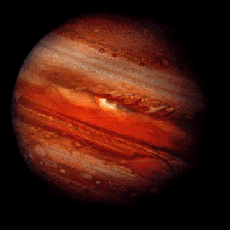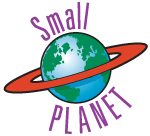Small Planet Communications, Inc. + 15 Union Street, Lawrence, MA 01840 + (978) 794-2201 + Contact

Answers to Questions About Jupiter

Answers to Questions About Jupiter
- How many kilometers are in one AU? This distance is the mean (or average) distance between what two objects?
One AU equals 149,597,870,700 m (about 149,597,871 km, or 92,955,807 miles), which represents the average distance between the Earth and the Sun. (To learn more about this unit of measurement, visit this Jet Propulsion Laboratory webpage.) - Is Jupiter a bright or a faint object in Earth's sky? What objects are brighter than Jupiter? What are some other bright objects that can be seen without a telescope from Earth?
Yes, Jupiter is relatively bright. Only the Sun, the Moon, Venus, and sometimes Mars are brighter. Other bright objects in Earth's sky include Mercury, Saturn, Ganymede, Io, Europa, Uranus, and Callisto. (To learn more about Jupiter, visit the Jupiter page on the NASA website.) - What is a gas planet? Which of the planets in our solar system are gas planets?
Jupiter and Saturn are the gas giant planets. Both planets are made up mostly of helium and hydrogen. Jupiter is the largest planet in our solar system while Saturn is the second largest. Jupiter also has clouds of ammonia and water that float in its atmosphere, but it doesn’t have a solid surface like Earth. Saturn’s rings are mostly made up of ice and rock. Of note: Jupiter and Saturn are also outer planets, along with the ice giant planets of Uranus and Neptune. The inner planets are Mercury, Venus, Earth, and Mars. Pluto is considered a dwarf planet. (To learn more about our solar system, visit the Our Solar System page on the NASA website.) - What kind of material makes up Jupiter's core? What is the next layer composed of? What is ice made of in our solar system?
Much like the makeup of the Sun, Jupiter’s composition is mostly helium and hydrogen. However, scientists are still unsure about exactly what materials make up Jupiter’s core—whether it’s made of solid substances or if it’s more like a thick soup. Surrounding Jupiter’s unknown core is the solar system’s largest ocean, made of hydrogen, not water. At Jupiter’s ocean’s deepest levels, the pressure on these hydrogen atoms is so great that they act like liquid metal. Jupiter’s atmosphere is made up of ammonia ice, ammonium hydrosulfide crystals, and water ice and vapor. (To learn more about Jupiter’s structure and composition, visit the Jupiter in Depth page on the NASA website.)
Throughout our solar system—and beyond—ice can be found. On our planet, as you know, there is water ice, but Pluto has three kinds of ice, made up of frozen nitrogen, methane, or carbon monoxide, while Mars has ice made of frozen carbon dioxide. (To learn more about ice in our solar system, visit the Frozen: Ice on Earth and Well Beyond page on the NASA website.) - In what states (solid, liquid, or gaseous) does hydrogen exist on Jupiter? What does an observer see when looking at the surface of Jupiter from far away? Would a spacecraft be able to land on the surface of Jupiter? Why, or why not?
On Jupiter, hydrogen is in gaseous and liquid states. Scientists are still trying to determine if Jupiter’s core is solid or not. When viewing Jupiter from far away, one might see some of its many moons—79 of them have been found so far! Like Saturn, Jupiter also has rings, but these are difficult to see unlike Saturn’s. The stripes and swirls we see around Jupiter are clouds of water and ammonia, drifting above hydrogen and helium gases, which make up its atmosphere. Because there is no solid surface to Jupiter—and because the planet has such extreme pressures and temperatures—today’s spacecrafts cannot land on our solar system’s largest planet. (To learn more about Jupiter’s structure and composition, visit the Jupiter in Depth page on the NASA website.) - When was the spacecraft Galileo launched? When did it first encounter Jupiter? What information has the Galileo probe sent back from Jupiter?
Galileo first encountered Jupiter on December 7, 1995, more than six years after being launched from the Space Shuttle Atlantis, in October 1989. The Galileo mission lasted 14 years, making many important discoveries, before it was deliberately maneuvered into Jupiter’s atmosphere and destroyed during its final exploration of the planet. Galileo surveyed Jupiter’s moons and its probe descended deep into the planet’s atmosphere to provide our first direct evidence of the interior of a gas giant, one of its many key discoveries. (To learn more about the Galileo mission, visit the Galileo Overview page on the NASA website.)
On August 5, 2011, the Juno orbiter was launched, starting a new exploration of Jupiter. (For more on the Juno mission, visit the Missions: Juno page on the NASA website.) - What is the Great Red Spot—what does it look like, how big is it, and what causes it?
Since its first official sighting in 1831, amateur and professional astronomers have been fascinated by the churning storm on Jupiter, called the Great Red Spot. At one point, this vortex was big enough to encompass more than three Earths, but it has been shrinking in size and changing in shape and height for decades now. Currently, it can contain “just” a bit more than one Earth, but it is also getting much taller in height. The Great Red Spot is also changing in color, becoming more deeply orange. Like a hurricane on Earth—only much, much larger and intense—this high-pressure storm on Jupiter is considered one of the most ancient, longest-lasting storms in our solar system. (For more information on the Great Red Spot, visit the Jupiter’s Great Red Spot Getting Taller as It Shrinks page on the NASA website.) - Does Jupiter have rings? If so, how do they compare to Saturn's rings?
Yes, Jupiter does have rings. They are fainter than Saturn's rings, and most scientists did not believe they were there until they were directly observed by Voyager 1. (To learn more about Jupiter and its rings, visit the Jupiter in Depth page on the NASA website.) - When was Comet Shoemaker-Levy 9 discovered, and by whom? When and why did the comet break into 21 fragments?
Shoemaker-Levy 9—SL9—was discovered by Carolyn and Eugene Shoemaker and David Levy in 1993. The comet had been orbiting Jupiter for about ten years before it passed too close to Jupiter and broke into fragments. Scientists think that Jupiter’s strong tidal forces, resulting from the planet’s gravity, caused SL9 to break apart. (To learn more about the comet and its discovery, visit the P/Shoemaker-Levy 9 page on the NASA website.) - In what way was SL9’s collision with Jupiter a “first” for planetary scientists?
Between July 16–22, 1994, SL9’s fragments crashed into the tops of Jupiter’s clouds. SL9 represented the first time scientists were able to observe a collision between two extraterrestrial objects. (To learn more about the comet and its discovery, visit the P/Shoemaker-Levy 9 page on the NASA website.)

Answers to SL9 Data Log
- Before it collided with Jupiter, for how many years do scientists believe SL9 had orbited the planet? About how many years did it take for the comet to orbit Jupiter once?
Scientists estimate that SL9 had been orbiting Jupiter for at least two decades, with an orbital period of about two years. (This information is on the comet page at the NSSDC site.) - What system did scientists use to name each fragment of SL9? Which fragment was thought to be the largest, and why?
The fragments were assigned letters from A to W (excluding I and O). Fragment Q was believed to be the largest because it appeared brightest. (This information is on the comet page at the NSSDC site.) - The impacts occurred on the far side of Jupiter, from Earth's perspective. How were we able to observe the effects of the collision? How long did scientists on Earth have to wait to get a look at the impact sites?
Scientists had to wait for Jupiter to rotate so that the impact sites were facing Earth. This took about 11 minutes. Since Jupiter is so far from Earth, the scientists then had to wait about 48 minutes for light to travel from Jupiter to Earth. (This information is on the impact page at the NSSDC site.) - What was the predicted date and time of impact of fragment Q1? When did it actually hit?
Fragment Q1 was expected to strike Jupiter on July 20, 1994, at about 8:04 p.m. It actually hit at about 8:12 p.m. that day. (This information is on the impact page at the NSSDC site.) - Describe what happened when a fragment hit Jupiter.
Each fragment traveled through the atmosphere and then exploded, creating a fireball that rose back above the cloud tops. The explosion produced pressure waves in the atmosphere and "surface waves" at the cloud tops. The rising material may have been a mixture of vaporized comet and Jovian atmosphere. (This information is from the impact page at the NSSDC site. The article "A Comet's Fiery Dance at Jupiter," from the May 1995 Galileo Messenger, gives a similar account.) - The Hubble Space Telescope was used to observe activities on Jupiter during the comet's impact. What unusual events involving Jupiter's aurorae (glowing gases in the atmosphere) did HST reveal? What comet fragment caused this activity?
Fragment K disrupted the radiation belts around Jupiter, resulting in a temporary, bright glow in the aurorae. Astronomers believe the K impact created an electromagnetic disturbance that scattered charged particles into Jupiter's upper atmosphere. Unexpectedly bright X-ray emissions were also detected near the time of the K impact. (This information is in the article "Hubble Observations Shed New Light on Jupiter Collision," on JPL's website.) - What have scientists learned from data collected after the comet's impact? Specifically, what have they learned about Jupiter's wind patterns?
Scientists have tracked the clouds of dust and smoke released into Jupiter's atmosphere to learn about the wind patterns there. They've discovered that winds in the upper atmosphere travel in different directions than those in the lower levels. In some regions, the SL9 dust in the upper atmosphere traveled north, away from the southern polar, whereas other regions showed no evidence of this northerly wind. Dust in lower atmospheric levels has been carried east/west. (For more information about the comet, check out the Comet Shoemaker-Levy Collision with Jupiter page on JPL’s website.)
Return to the Comet Shoemaker-Levy 9 Page.


